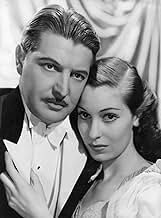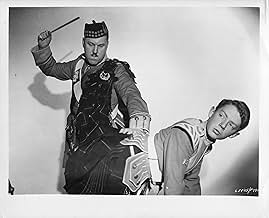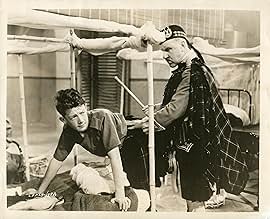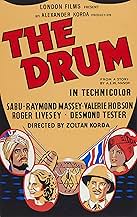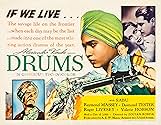AVALIAÇÃO DA IMDb
6,3/10
997
SUA AVALIAÇÃO
Adicionar um enredo no seu idiomaIn British India, Captain Carruthers investigates arms smuggling on the North West Frontier. The governor makes peace with Tokot's ruler. Prince Azim bonds with Carruthers and learns drums f... Ler tudoIn British India, Captain Carruthers investigates arms smuggling on the North West Frontier. The governor makes peace with Tokot's ruler. Prince Azim bonds with Carruthers and learns drums from British boy Bill Holder.In British India, Captain Carruthers investigates arms smuggling on the North West Frontier. The governor makes peace with Tokot's ruler. Prince Azim bonds with Carruthers and learns drums from British boy Bill Holder.
- Direção
- Roteiristas
- Artistas
- Prêmios
- 1 vitória e 1 indicação no total
Francis L. Sullivan
- Governor
- (as Francis L.Sullivan)
Laurence Baskcomb
- Zarullah
- (as Lawrence Baskcomb)
Julien Mitchell
- Sergeant
- (as Julian Mitchell)
Avaliações em destaque
The film location is always shown as India but in fact part of the film was shot in the snowdonia range of mountains, in a place called Cwm Bychan lake,llanbeder in the county of Gwynedd. My Father was an extra on this film and I noticed that no mention has ever been made that part of the filming was actually done in North Wales
Unabashedly pro-Raj, the story of a young Indian Prince and his friendship with some British army types. The release of this film was reported to have sparked anti-British riots in India. Sabu outdoes himself as the spunky and, ultimately, obsequious Prince who lines up with his friend/occupiers to battle the deliciously evil Raymond Massey. Very politically incorrect by today's standards the film is a good adventure yarn as well as a Korda tribute to the the rapidly vanishing British Empire. The plot borrows elements from the real life killing of Sir Louis Cavagnari and his party years earlier in Afghanistan. In reality British and colonial forces were actively engaged in military operations in Waziristan at the time of the making of the film.
Plot-- British colonial rule in parts of India is imperiled by the murder of the local monarch by his sinister brother (Massey). Now the British contingent (Livesey, Hobson, et al.) must rely on the young pro-British nephew (Sabu) to rally against the usurper.
As a boy growing up in a small mid-western town, I never missed this epic and its companion feature Four Feathers (1939) in our theater. After all, where else in pre-TV middle America could all that scenic exotica be seen. The be-turbaned Indian natives, the be-skirted English soldiers, the high mountain passes, all in rich Technicolor, along with the rich pageantry of masses of people moving here and there. And shouldn't forget the crackling, if somewhat clichéd, storyline, along with a charmingly youthful Sabu, a gloweringly sinister Raymond Massey, and a slim, long-limbed Valerie Hobson. Then there's that thundering drum, along with slinky native girls and twirling British Highlanders. The Korda's certainly spared no expense and it shows, from spirited opening to satisfying close. Sure, the subtext amounts to British colonial propaganda that no longer wears well. Still, the lavish spectacle remains, a treat for the eye. Of course, I've changed in many ways from those earlier days, but the Korda production can still entertain and impress, if given half a chance.
As a boy growing up in a small mid-western town, I never missed this epic and its companion feature Four Feathers (1939) in our theater. After all, where else in pre-TV middle America could all that scenic exotica be seen. The be-turbaned Indian natives, the be-skirted English soldiers, the high mountain passes, all in rich Technicolor, along with the rich pageantry of masses of people moving here and there. And shouldn't forget the crackling, if somewhat clichéd, storyline, along with a charmingly youthful Sabu, a gloweringly sinister Raymond Massey, and a slim, long-limbed Valerie Hobson. Then there's that thundering drum, along with slinky native girls and twirling British Highlanders. The Korda's certainly spared no expense and it shows, from spirited opening to satisfying close. Sure, the subtext amounts to British colonial propaganda that no longer wears well. Still, the lavish spectacle remains, a treat for the eye. Of course, I've changed in many ways from those earlier days, but the Korda production can still entertain and impress, if given half a chance.
Great morale booster for the British people, with another World War looming. Shows the bonding between British and Indians that contributed to the long sojourn of the British in India. Definitely a boy's film with all the majesty that the Empire films of the thirties could muster for audiences suffering from economic depression and worries over the rise of fascism and its onward march. Roger Livesey's character brings to life the type of relationship that so many British civilians and civil servants enjoyed with Indians, so sadly ignored/forgotten in the interest of history revision and political correctness.
From 'Kim' to 'Carry On up the Khyber', from the famous to the infamous (stand up, Harry Flashman!), the North-West Frontier has proved a fertile source of conflict both fictional and historical... and deposed rulers and fiery mullahs have figured largely from that day to this. The plot of 'The Drum' cribs heavily (and at one point openly, with an impudently-inserted piece of dialogue listing the historical parallels that had been niggling at me!) from real-life events, especially in Afghanistan, and as other stories before and since have been based on the same material, this can result in a certain 'seen-it-all-before' sensation. But the winning element in this film is the touch of humanity and humour which helps the characters to become more than cardboard templates, from the drummer-boy and his misfortunes to the wry jests of the newly-appointed British representative walking open-eyed into a trap. Not to mention that, after a spate of films with seemingly pointless titles, I found it obscurely satisfying to encounter one where the eponymous instrument is actually significant both to the plot and its climax!
The always-excellent Sabu steals the film, as ever, in his role first as a self-possessed princeling and then as a fugitive in exile from his throne; the romantic leads, while well-performed, are less memorable. The tension in the banquet scene is tangible, and Raymond Massey as the usurper brings brains as well as menace to his role. The one element that rather shocked me -- with the exception of the inadvertent glimpse of buttock that reveals exactly what Scotsmen do or don't wear under their kilts! -- was the scene in which the said usurper is shot down by our wounded hero in cold blood, having thrown down his weapon. It's not customary for such an act to be depicted in an apparently approving manner; and certainly not in a film of this period...
I must admit that the question of the period itself had me slightly puzzled, although the mention of syncopation in the drum part for the dance should have given me a clue. I had automatically assumed the story to be set in nineteenth-century India in the heyday of the Raj rather than the contemporary world, and with few European civilian fashions on display, there was nothing to disabuse me of this until the heroine made an appearance in jodhpurs, which came as something of a shock! (And the subconscious resonance with the valleys of 'Carry On up the Khyber' turns out to be based in fact: locations from both were shot in Wales...)
But 'The Drum' is a rousing adventure as they used to make 'em, in the tradition of 'Charge of the Light Brigade' or 'Northwest Frontier'; if you like the genre, this one is a cracker.
The always-excellent Sabu steals the film, as ever, in his role first as a self-possessed princeling and then as a fugitive in exile from his throne; the romantic leads, while well-performed, are less memorable. The tension in the banquet scene is tangible, and Raymond Massey as the usurper brings brains as well as menace to his role. The one element that rather shocked me -- with the exception of the inadvertent glimpse of buttock that reveals exactly what Scotsmen do or don't wear under their kilts! -- was the scene in which the said usurper is shot down by our wounded hero in cold blood, having thrown down his weapon. It's not customary for such an act to be depicted in an apparently approving manner; and certainly not in a film of this period...
I must admit that the question of the period itself had me slightly puzzled, although the mention of syncopation in the drum part for the dance should have given me a clue. I had automatically assumed the story to be set in nineteenth-century India in the heyday of the Raj rather than the contemporary world, and with few European civilian fashions on display, there was nothing to disabuse me of this until the heroine made an appearance in jodhpurs, which came as something of a shock! (And the subconscious resonance with the valleys of 'Carry On up the Khyber' turns out to be based in fact: locations from both were shot in Wales...)
But 'The Drum' is a rousing adventure as they used to make 'em, in the tradition of 'Charge of the Light Brigade' or 'Northwest Frontier'; if you like the genre, this one is a cracker.
Você sabia?
- CuriosidadesThe film caused protests when shown in Bombay and Madras, as it was considered by many to be British propaganda.
- Versões alternativasVersion shown on Turner Classic Movies from "The Criterion Collection" runs 93 minutes
- ConexõesFeatured in Family Classics: Family Classics: The Drum (1964)
Principais escolhas
Faça login para avaliar e ver a lista de recomendações personalizadas
- How long is The Drum?Fornecido pela Alexa
Detalhes
- Tempo de duração
- 1 h 44 min(104 min)
- Proporção
- 1.37 : 1
Contribua para esta página
Sugerir uma alteração ou adicionar conteúdo ausente

